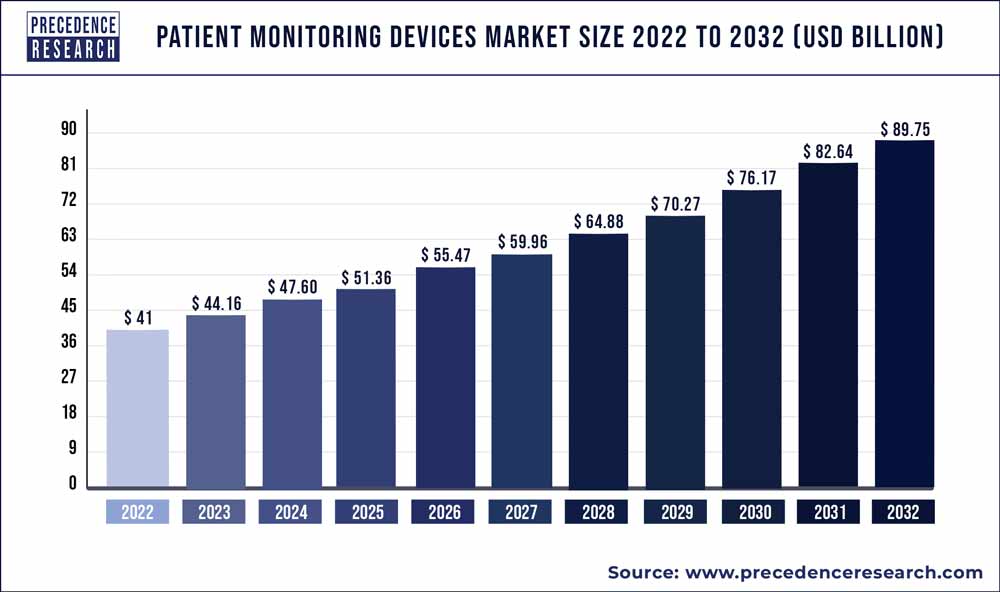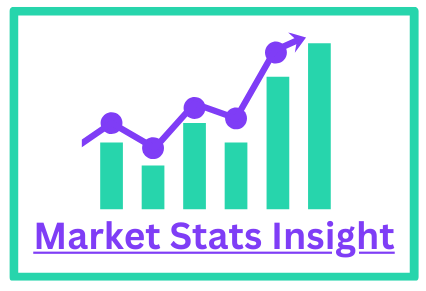Market Size and Growth Projections
The global patient monitoring devices market is projected to experience robust growth, with market size expected to reach approximately USD 89.75 billion by 2032 from valued at USD 41 billion in 2022, growing at a compound annual growth rate (CAGR) of around 8.2% from 2023 to 2032. This growth is attributed to several factors, including technological advancements, increasing healthcare expenditure, and a rising need for efficient and effective patient management solutions.

Introduction
Patient monitoring devices are crucial in modern healthcare, enabling continuous observation of vital signs and other critical health parameters. These devices are instrumental in various healthcare settings, from hospitals and clinics to home care, ensuring real-time data collection and timely intervention. The patient monitoring devices market has seen significant growth over the past few decades, driven by advancements in technology, an aging population, the prevalence of chronic diseases, and an increasing focus on remote and home healthcare.
Get a Sample: https://www.precedenceresearch.com/sample/1288
Key Market Drivers
- Technological Advancements: The development of advanced monitoring systems equipped with wireless technology, integrated with electronic health records (EHR), and powered by artificial intelligence (AI) has significantly boosted the market. These innovations enhance the accuracy of monitoring and facilitate better patient outcomes.
- Aging Population: The global population is aging, with a significant increase in the number of elderly individuals who are more prone to chronic diseases and conditions requiring constant monitoring. This demographic shift is a substantial driver of market growth.
- Prevalence of Chronic Diseases: The rising incidence of chronic diseases such as cardiovascular diseases, diabetes, and respiratory disorders necessitates continuous monitoring, thereby driving the demand for patient monitoring devices.
- Focus on Remote and Home Healthcare: There is a growing trend towards home healthcare and remote monitoring, which is more convenient and cost-effective for patients. The COVID-19 pandemic further accelerated this trend, highlighting the importance of remote patient monitoring systems.
- Healthcare Expenditure: Increased healthcare spending by governments and private entities worldwide supports the adoption of advanced patient monitoring technologies.
Read Report: Nitrile Gloves Market Size to Worth USD 39.9 Bn by 2032
Market Segmentation
By Product Type
- Cardiac Monitoring Devices: These include ECG monitors, event monitors, and implantable loop recorders. Cardiac monitoring devices are essential for diagnosing and managing heart conditions, contributing significantly to market revenue.
- Respiratory Monitoring Devices: Devices such as pulse oximeters, capnographs, and spirometers fall into this category. The increasing prevalence of respiratory diseases like COPD and asthma boosts the demand for these devices.
- Neuromonitoring Devices: EEG machines, EMG machines, and intracranial pressure monitors are crucial for monitoring neurological conditions. The rising incidence of neurological disorders propels the growth of this segment.
- Hemodynamic Monitoring Devices: These include blood pressure monitors, cardiac output monitors, and central venous pressure monitors. They are vital in critical care settings for monitoring patients’ cardiovascular status.
- Fetal and Neonatal Monitoring Devices: These devices are used to monitor fetal heart rate, uterine contractions, and the health of newborns. They are crucial in ensuring the health and safety of both mother and child during pregnancy and childbirth.
- Multi-Parameter Monitoring Devices: These devices measure multiple parameters such as ECG, respiratory rate, blood pressure, and temperature simultaneously. They are widely used in critical care and surgical settings.
By End-User
- Hospitals and Clinics: Hospitals and clinics are the primary end-users of patient monitoring devices, owing to the high volume of patients and the need for comprehensive monitoring solutions.
- Home Care Settings: The shift towards home healthcare has led to increased adoption of portable and user-friendly monitoring devices by patients for self-monitoring and management of chronic conditions.
- Ambulatory Surgical Centers: These centers require efficient monitoring devices to ensure patient safety during and after surgical procedures.
- Others: This segment includes long-term care facilities, nursing homes, and emergency medical services.
By Region
- North America: North America holds a significant share of the patient monitoring devices market, driven by advanced healthcare infrastructure, high healthcare expenditure, and the presence of key market players. The U.S. is the largest market in this region.
- Europe: Europe is another major market, with countries like Germany, France, and the UK leading in terms of adoption of advanced patient monitoring technologies. The region’s well-established healthcare system and favorable reimbursement policies contribute to market growth.
- Asia Pacific: The Asia Pacific region is expected to witness the highest growth rate during the forecast period, attributed to the growing population, increasing prevalence of chronic diseases, and rising healthcare expenditure in countries like China, India, and Japan.
- Latin America: This region is also experiencing growth in the patient monitoring devices market, driven by improving healthcare infrastructure and increasing government initiatives to enhance healthcare services.
- Middle East and Africa: The market in this region is growing steadily, with a focus on improving healthcare facilities and increasing awareness about advanced monitoring solutions.
Technological Trends
Wireless and Wearable Monitoring Devices
The development of wireless and wearable patient monitoring devices has revolutionized the market. These devices enable continuous and real-time monitoring of patients’ health parameters without the need for constant hospital visits. Wearable devices such as smartwatches and fitness bands equipped with sensors can monitor heart rate, blood pressure, and oxygen levels, providing valuable data for both patients and healthcare providers.
Integration with Electronic Health Records (EHR)
Integrating patient monitoring devices with EHR systems enhances the efficiency of healthcare delivery. It allows seamless data sharing between different healthcare providers, ensuring continuity of care and better patient outcomes. This integration also helps in reducing errors and improving clinical decision-making.
Artificial Intelligence and Big Data Analytics
AI and big data analytics play a crucial role in the patient monitoring devices market. AI algorithms can analyze vast amounts of data generated by monitoring devices, identifying patterns and predicting potential health issues before they become critical. This predictive capability helps in early intervention and better management of chronic diseases.
Telemedicine and Remote Monitoring
The COVID-19 pandemic accelerated the adoption of telemedicine and remote monitoring solutions. These technologies allow healthcare providers to monitor patients remotely, reducing the need for physical visits and minimizing the risk of infection. Remote monitoring devices equipped with video conferencing capabilities enable real-time consultations and follow-ups.
Regulatory Landscape
The patient monitoring devices market is highly regulated to ensure the safety and efficacy of the devices. Regulatory bodies such as the U.S. Food and Drug Administration (FDA), European Medicines Agency (EMA), and other national regulatory authorities play a crucial role in the approval and monitoring of these devices. Compliance with regulatory standards is essential for market players to launch and market their products.
Competitive Landscape
The patient monitoring devices market is highly competitive, with several key players dominating the market. Some of the prominent players in the market include:
- Medtronic plc: A leading player in the patient monitoring devices market, Medtronic offers a wide range of monitoring solutions, including cardiac monitoring, respiratory monitoring, and multi-parameter monitoring devices.
- Philips Healthcare: Philips is known for its innovative patient monitoring systems that integrate advanced technologies like AI and big data analytics. The company focuses on providing comprehensive monitoring solutions for various healthcare settings.
- GE Healthcare: GE Healthcare offers a broad portfolio of patient monitoring devices, including cardiac, respiratory, and fetal monitoring systems. The company emphasizes technological advancements and integration with EHR systems.
- Nihon Kohden Corporation: A key player in the market, Nihon Kohden specializes in neuromonitoring and multi-parameter monitoring devices. The company is known for its high-quality and reliable monitoring solutions.
- Masimo Corporation: Masimo is a leader in non-invasive monitoring technologies, offering innovative solutions for pulse oximetry and advanced hemodynamic monitoring.
Challenges and Opportunities
Challenges
- High Cost of Devices: The high cost of advanced patient monitoring devices can be a barrier to adoption, especially in low- and middle-income countries.
- Data Privacy and Security: With the increasing use of digital and connected monitoring devices, ensuring data privacy and security is a significant challenge. Healthcare providers must comply with stringent data protection regulations to safeguard patient information.
- Regulatory Compliance: Navigating the complex regulatory landscape and ensuring compliance with various standards can be challenging for market players, especially for new entrants.
Opportunities
- Emerging Markets: Emerging markets in Asia Pacific, Latin America, and Africa offer significant growth opportunities due to improving healthcare infrastructure and increasing awareness about advanced monitoring solutions.
- Integration with AI and IoT: Continued integration of AI and IoT technologies with patient monitoring devices presents opportunities for innovation and development of more advanced and efficient monitoring systems.
- Telehealth and Remote Monitoring: The growing trend of telehealth and remote monitoring offers opportunities for market players to develop and offer innovative solutions that cater to this expanding segment.
Future Outlook
The future of the patient monitoring devices market looks promising, with continued advancements in technology and increasing adoption of remote and home healthcare solutions. The integration of AI, big data analytics, and IoT will further enhance the capabilities of monitoring devices, enabling more precise and timely interventions.
Personalized Monitoring Solutions
The trend towards personalized medicine is expected to influence the patient monitoring devices market. Personalized monitoring solutions that cater to individual patient needs and conditions will become more prevalent, offering tailored healthcare experiences and improving patient outcomes.
Expansion of Telehealth Services
The expansion of telehealth services will continue to drive the demand for remote patient monitoring devices. As healthcare providers and patients increasingly embrace telehealth, the need for efficient and reliable monitoring solutions will grow.
Focus on Preventive Healthcare
There will be a growing focus on preventive healthcare, with monitoring devices playing a crucial role in early detection and management of health conditions. This shift towards preventive care will drive the development of advanced monitoring solutions that.
Immediate Delivery Available | Buy This Premium Research Report@ https://www.precedenceresearch.com/checkout/1288
